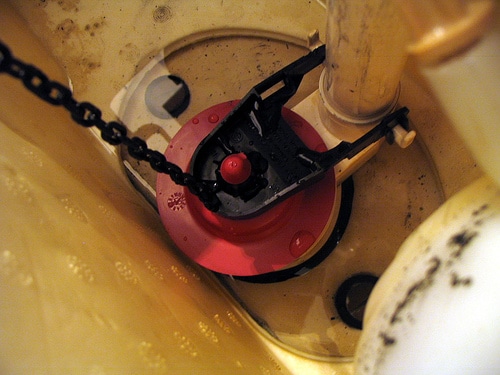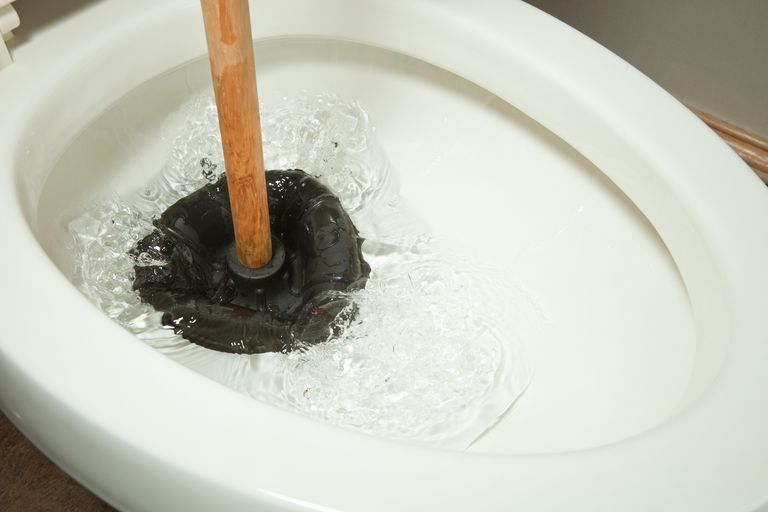How to Unclog a Toilet Like a Plumber
Stop the Toilet Bowl From Filling Up.
If it looks like the water might overflow out of the toilet, Rod suggests taking the lid off the tank as quickly as possible and closing the toilet flapper. The flapper releases water from the tank and into the bowl. It looks like, well, a flapper. If you’re worried that your flush has a good chance of turning into a flood, take off the top before you pull the trigger. Then you can keep one hand close to the flapper while the other hands pushes the flusher. The minute it appears the water is rising, you’re ready to stop the deluge.
Get the Right Plunger
Once disaster has been averted, it’s time to unsheathe your plunger. To effectively use a plunger, you need a good seal between it and the toilet bowl. Funnel-cup plungers are the best plungers for this. They’re the ones with a flange, or added piece, extending off the bottom of the rubber cup.
Warm Up Your Plunger
Stiff, hard plungers don’t work as well as soft and pliant ones. Run your plunger under some hot water before you use it. This will soften up the rubber, which will help you get a better seal on the toilet bowl.
Plunge Correctly
Stick the plunger in the bowl and use it to form a solid seal over the exit hole. Rod said that most people only focus on the downward push when plunging. But the pullback is just as important. Give a few good up and down strokes with the plunger and flush the toilet. If the water clears from the toilet, then you’ve successfully unclogged it. If the toilet starts overflowing again, just close the flapper to stop water from entering the bowl. Repeat the plunge and flush sequence until your clog is gone.
Secret Plumber Trick: Add Hot Water and Dishwasher Detergent.
Add a few cups of hot water to the toilet bowl before you start plunging. After you pour the hot water in, let it sit for a few minutes. To put it mildly, the heat helps break the, um, stuff up. This will make unclogging the toilet with the plunger much, much easier. The heat from the hot water can sometimes break up the clog without plunging, so this could be a good tactic to use if you a clog a toilet at a friends house and you don’t want to face the embarrassment of asking for a plunger.

You Can Unclog a Toilet Bowl Without a Plunger
Plunger Alternative: Start With Dish Soap
As soon as the toilet clogs, learn how to unclog a toilet without a plunger and head to the kitchen and fetch some dish soap; the slippery soap should help lubricate the clogged pipe and allow the lodged debris slide down more easily. Pour about a half-cup into the toilet. If you haven’t got any dish soap on hand, chop a bar of soap into small chunks and drop the pieces into the toilet.
Plus, Check Out the Best Toilet Paper for Your Plumbing
We tested toilet paper breakdown and this is what happened.
Add Hot Water
If dish soap alone doesn’t do the trick for how to unclog a toilet without a plunger, adding water might move things along. Fill a bucket with hot bath water (boiling water could cause a porcelain toilet to crack), and pour the water into the toilet from waist level. The force of the water could dislodge whatever is causing the clog.
DIY a Drain Snake Using a Wire Hanger
A more severe blockage could require manually moving the item. To do this without a plunger, unravel a wire coat hanger until it’s straight. Push one end of the wire into the clogged area. Prod the debris until it becomes free and flows down the drain. Voila! Another way to unclog a toilet without a plunger.
Plunger Alternative: Try This Mixture
As an alternative to using dish soap and no plunger, try this all-natural solution: Pour 1 cup baking soda and 2 cups vinegar into the toilet. Allow it fizz for a half hour. If clog doesn’t dissipate, try the hot water trick.
Unclog your toilet with this simple and ingenious trick — no plunger required
Most bathrooms have everything you’ll need
To perform this trick, you’ll need three things that can be found in almost any bathroom: soap, hot water and a vessel for transferring the water to the toilet bowl. Dish soap and a 5-gallon bucket work best, but if secrecy is paramount and leaving the lavatory would blow your cover, a small plastic waste bin and a few pumps from a hand soap dispenser will do just fine.
Mixing the magical potion
The objective is to get the liquid in the toilet bowl as hot and soapy as possible without letting it overflow. You can either pour (or pump) soap directly into the bowl and then add hot water, or you can mix the soap with the hot water before you add it to the bowl.
Carefully and gently add the hot water
Mixing everything up in the toilet bowl is the step requiring the most finesse. You want to raise the average water temperature and get the soap into every crevice, but you don’t necessarily want to create a slurry with what’s already in there.
If all else fails, time is on your side
The worst-case scenario is that the clog is wedged too tightly in place and the above steps don’t push it down right away. If that happens, you don’t have to call a plumber or head to the hardware store just yet.
The One Surefire Way To Unclog a Toilet
Clogged the toilet? Don’t panic. A toilet clogged with human waste is disgusting and can be embarrassing, but it’s easy to fix. I’ve unclogged countless stoppages for my family and friends, and during volunteer work. What I write here isn’t theory. It works.
The lower portion of the toilet is called the stool. If the stool is filled with water and getting close to overflowing the rim, shut off the stop valve that supplies water to the toilet. The valve typically is located to your left as you stand and look at the toilet. In rare cases, when the toilet isn’t close to a corner, it may be on the right.
Take a coat hanger and a pair of linesman pliers (or anything that can cut wire). Cut the hook off the coat hanger. Bend the hanger into a straight rod and use the pliers to bend a small one-inch-long hook into the wire’s end. Hook into the waste and break it up. Yes, this process is gross and may make you gag, but do you want to clear the clog or not?

Easier Ways to Clear a Clog
Heat Wave
When you notice a nasty clog, your best bet is to fill a pan with hot water. Heat it up on the stove or use the tap, but don’t let the water get to boiling point. Pour it down the drain and let it sit for a few minutes to see if it loosens the clog. You’ll know if your efforts were successful if you see the water start to drain. Then, give the toilet a flush or two. In many cases, the hot water is enough to break up whatever is causing the backup.
Dish Duty
If you need to kick things up a notch, borrow some dish soap from the kitchen and squeeze a generous amount, about a 1/4 cup should do, into the toilet bowl. Let the soap sit for 5-10 minutes so it has time to move down the drain and reach the clog. Then, add hot water (again, not boiling) to the bowl and give it some time to sit. In most cases, the soap will act as a lubricant and grease the clog in the toilet drain to get everything moving again.
Fizzy Fix
It’s time to channel what you learned in elementary school science! If your toilet bowl is already filled to the brim, either empty out some of the water or be prepared for a little overflow. Next, pour one cup of baking soda and one cup of vinegar down the toilet drain. When the vinegar and baking soda combine, the natural chemical reaction will bubble up and loosen the clog. After about thirty minutes, follow up with some hot water and see if it drains. If it does, you’re good to go. If it doesn’t, repeat the process once more.
Brush Battle
This may seem a little unpleasant, but if you’re really in a bind and there’s no plunger in sight, grab a toilet brush and angle the bristles down the drain. Pumping up and down a few times should be enough to loosen things up so the clog clears in no time.